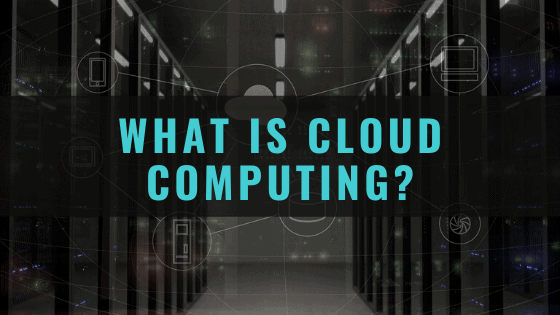What is Cloud Computing? Everything you need to know

Cloud computing – refers to the practice of providing on-demand computing services through online means. This includes storage spaces, processing power and other resources, which users purchase through the internet.
Without a doubt, cloud computing is the future of the computing industry. As more and more services are becoming available online, the industry is growing dramatically and competition is becoming more steep.
But how did it all start and is it really that important to the service sector in general? Today I want to talk about cloud computing and all there is to it.
How does cloud computing actually work?
Back in the old days, if you wanted to store large amounts of data or have faster speed for your website, you had to actually go out and buy your own infrastructure of computers in order to achieve the desired result.
Modern technologies, however, have enabled users to buy or rent whatever computing services they might need starting from simple applications to large amounts of online storage and something like a good hosting service for their website.
Instead of worrying about the maintenance costs of running a data center and buying a physical computer network, casual website owners can nowadays simply purchase what they need for a fixed price.
On the other hand, cloud services have also benefited the providers themselves. With the help of the internet, they can reach thousands of customers worldwide instantly, thus cutting down costs of being able to maintain their resources.
In turn, providers of cloud computing services can benefit from significant economies of scale by delivering the same services to a wide range of customers.
What could be an example of a Cloud Computing service?
The term itself is pretty loose and covers a number of different computer-related services.
A simple example could be Google’s own Gmail, which stores your emails on its servers or data storage providers like Dropbox or Mega, which give you the opportunity to store videos, photos, documents and other files on their servers.
Another popular example could be Netflix or Amazon Prime – two giant video streaming services who rely entirely on cloud storage to make your favorite documentaries, films and TV-shows available right there on-demand.
Finally, there’s large business entities like hosting companies who not only offer their services through online means, but host their own data and software in its entirety on the cloud, as do many other large organizations.
I’d argue that cloud services and subscription -based business models are no longer just an option, they are becoming the standard means for businesses to provide their services for clients.
As there many benefits to it for both businesses and the users, I honestly believe that this is the direction the industry will be moving forward to and there’s nothing we can do about it.
The main benefits of cloud computing services

However, I think the correct thing would be to simply say that they enable a more efficient use of various computer infrastructures, for the users to use them, and for businesses to more easily sell them.
Forget such hassles like buying a server, constantly updating your OS to the latest version, or building hardware if you want to have decent speed or space for your business operations. All of that is taken care of by those who sell.
We don’t even think about things like emails and what servers can be used to store them, the cloud takes care of it easily, as the business that sells us cloud services can have practically unlimited space on the cloud.
Cloud services in general mean that various business decisions can be made far more easily and efficiently. Want to test something new on your website and need more space or speed? Few clicks and you’re ready.
Gone are the days where businesses stalled because of outdated technology, ideas crushed by lack of funding and the time needed to set up something new on your site. Not only cloud services are fast and give more opportunities, they’re also quite cheaper.
What about the history of cloud computing? How did it all came about?
The term cloud computing came from the idea that the location of the provider and the buyer of such services in the grand scheme of things, is pretty much irrelevant. You look to the sky, you see clouds, as does another person looking up to them from across the globe.
Not only that, but things like the operating system or server hardware specifics don’t really matter that much as well.
So, continuing with the concept from how the internet and the public phone networks were previously described, the cloud in this case means that the small components by themselves don’t matter much, but instead make up something big and accessible to everyone.
Pretty interesting metaphor if you ask me.
Of course, this is just me trying to simplify the definition as much as I can. To many people, details still do matter and they use their services based on that. Still, my general point stands.
Let’s say I want to buy a cloud service. What can I get?

The term cloud computing now covers a pretty vast spectrum of IT services from the very basics like cloud storage, virtual servers to complex, AI-based solutions for online businesses.
I think it would be fair to say that practically any service that doesn’t require you to be physically next to a computer, can be delivered via a cloud service.
Here are some of the main types/examples of Cloud Computing currently in-use:
| Cloud service usage type | Product/tool examples |
| Streaming | Netflix, Spotify, Youtube, SoundCloud. |
| Storage | Google Drive, MEGA, OneDrive, Dropbox. |
| Communication | Skype, Zoom, Discord, Microsoft Teams. |
| Social Media | Facebook, Twitter, Instagram, VK. |
| Productivity tools | Google Docs, Microsoft Office 365. |
| Testing/App Development | App Thwack, Nessus, BlazeMeter, LoadStorm. |
- Storage services – cloud storage is one of the oldest computing solutions of such type. Providers allow users to store various types of media, documents, applications and other files. The most popular cloud storage applications, I’d argue are – Apple’s “Dropbox”, Google’s “Google Drive”, Microsoft’s “OneDrive” and Mega Ltd’s “MEGA”. Each provides some space on the cloud for free, with extra scalable resources available for businesses with paid plans.
- Streaming platforms – other major users of cloud services are streaming platforms. Not many think about it, but in order to provide it’s great on-demand movie streams Netflix has to go to great lengths to ensure all of its content is available to users. This means using tons of storage to host their stuff, while simultaneously maintaining the same subscription fee for everyone. A really great example of cloud services.
- Social networks – another familiar example of cloud computing in effect are of course social media networks. Everything we do – post videos, pictures, chat with friends, “like” someone’s comment are stored as part of one big computer network connected via the cloud to that particular social media site. Thus, they’re crucial, if social media is to function like it does now.
- Communication tools – various tools such as Skype, Zoom, even email platforms could be named as examples of cloud computing. Just imagine what connecting millions of users would do to hardware centers of an application. By sharing the traffic and data load amongst multiple hosts as a result of cloud computing, communication tool providers are able to deliver services the way we like them.
- Productivity tools – obviously, productivity is crucial in any workplace. However, I’d argue that cloud computing has played a very big role in changing the way we understand productivity, especially in an office workplace. Tools like Google Docs or Microsoft Office 360 allow you to create Word, Excel and PowerPoint documents almost instantly and share them among colleagues or send to clients. Everything is on the cloud, available to everyone at any time.
- Testing platforms – another use of cloud computing that’s not talked about enough are testing platforms. Are developing a website, software applications or some other solutions? No longer do you have to worry about setting up a testing environment for your product. Here you can mess around with different machine types and see how everything functions.
Understanding the three main models of Cloud Computing services (IaaS, PaaS, SaaS)

The services/usage types of cloud computing that I described above, all follow a certain model by how the services are delivered to the end user.
These are the 3 main ones:
- Infrastructure-as-a-Service (IaaS)
- Platform-as-a-Service (PaaS)
- Software-as-a-Service (SaaS)
I shall now define them each for a better understanding.
- Infrastructure-as-a-Service (IaaS) – this cloud computing service model, refers to rentable virtual and physical servers, storage space and other tools. In other words, the very fundamental parts of what makes up the thing computing as such. Applications that fall under this model are mainly used by companies who want to develop something completely from scratch and just need the very basics which they otherwise couldn’t have – storage, speed, online security and so on. While there’s more technical knowledge involved here, IaaS platforms remain popular among those who want to develop, innovate and test their products without the hassle of building their own servers.
- Platform-as-a-Service (PaaS) – this next service model refers to the same infrastructural basics, but will also include additional software and tools which developers might need in order to build what they want. Any type of middleware, database management or developmental tools can help considerably when creating and testing out various software solutions, which is why a number of developers consider this type of cloud service for their use. As a result, the popularity of PaaS tools remains steady for a number of years now.
- Software-as-a-Service (SaaS) – the last major type of cloud computing refers to applications being sold to the user as services. Without a doubt, the most known cloud service model out there. Here, things like hardware, developmental or management tools are completely irrelevant to those who purchase as the application is at the forefront. Researchers say that SaaS is, and for the foreseeable future, should remain the most popular cloud computing model for businesses to buy and sell their services. This applies to most of the examples I gave above. Storage, streaming, communication and productivity tools are all designed to be used as a product, as it is for the users.
Who are the main “players” in the cloud computing industry?
For IaaS and PaaS platforms, there’s not much competition in the market, since most of them fall under a few giant providers. Google, Microsoft and of course Amazon all have their fair share of revenue, with Amazon clearly leading the way.
Despite being the 3 leading cloud service providers in the world, it could be argued that each of them have a different approach and focus with the market.
Amazon, for example, focuses on IaaS and PaaS type of cloud services, while Microsoft is strongly headed toward SaaS dominance, while also having a strong footing in IaaS and PaaS services thanks to the Microsoft Azure platform.
Google, it could be argued is somewhere in-between the two, offering a pretty balanced selection of cloud services.
How important is the cloud to the IT industry? The future of Cloud Computing
Obviously, IT by itself is one of the most important service sectors these days.
Cloud computing industries, economists say, make up around a third of total global IT revenue and are set to increase in the following years. This is because more and more businesses are moving to the cloud and traditional IT services are slowly losing revenue.
With this of course, the revenue from cloud services is also set to rise. In 2019, the global revenue was around 260 billion dollars and increases are projected to happen at around 10-15 billion every year.
All in all,
In this article I’ve described the main features of Cloud Computing, its types, working principles and future prospects. I honestly believe that businesses will be completely reshape within the next few years.
As more people will come to notice with cloud services, the question of what it is and whether to use it will be completely irrelevant and it’ll become standard practice.









